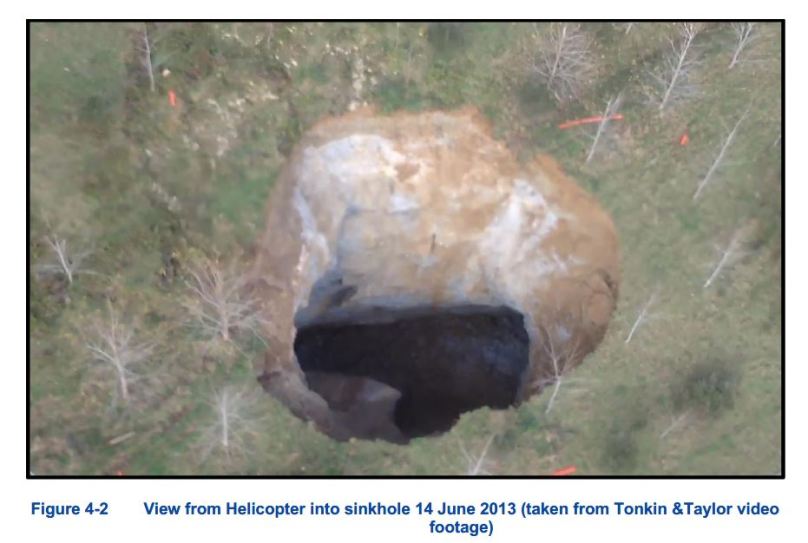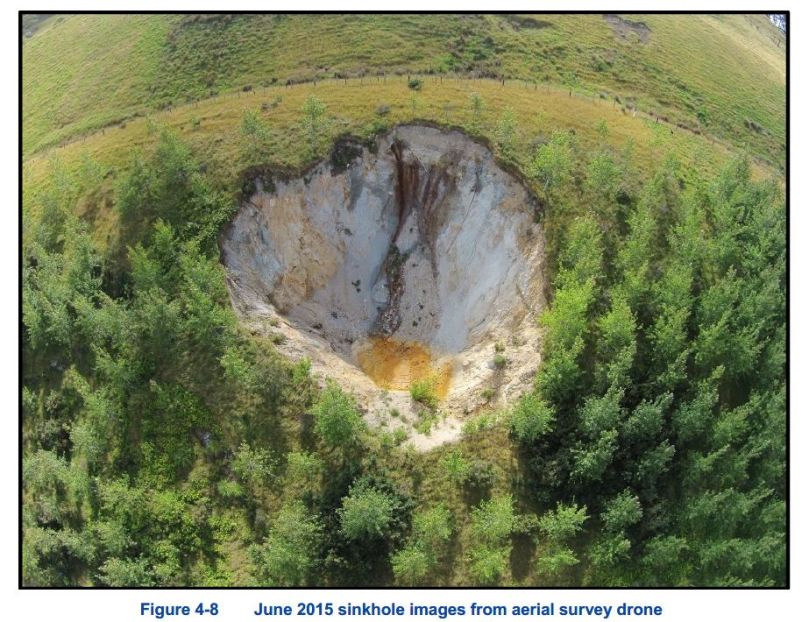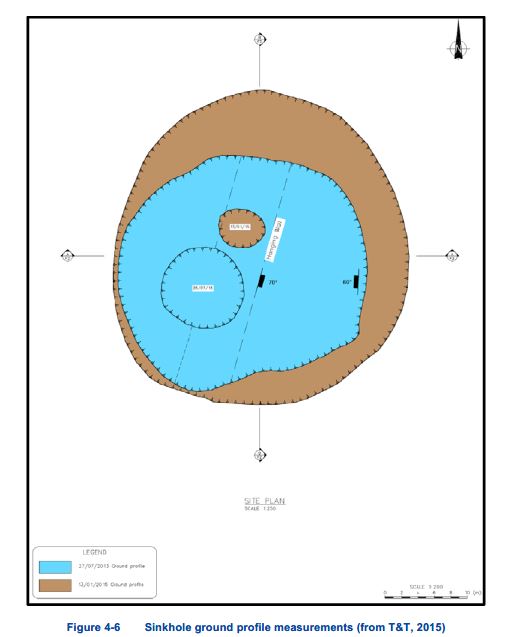A US-based gold mining company (Coeur Gold) has failed to properly back-fill its underground mine at Waitekauri near Waihi causing a large 40m wide sinkhole to collapse into the Empire Vein mine workings about 15 years later in 2013. The hole has opened a pathway for acidic leachate and heavy metal toxins to pollute ground water and streams. The regulators of the mine – the Waikato Regional Council (WRC) and Hauraki District Council (HDC) have taken no steps for nearly 4 years to require Coeur Gold to remedy the sinkhole. Nor have they taken any enforcement action for possible breach of its resource consents or mining licence. Coeur Gold has recently suggested to the regulators that rather than the company paying around $500,000 to fix the problem it created – the sinkhole should remain as a “vital reminder for future generations of what can happen” on mine sites. I kid you not. I am not making this up.
In June 2013 a helicopter crew on work unrelated to the Golden Cross mine near Waihi noticed a large sinkhole (crater) on the wall of the closed open-pit. (So much for “close monitoring” by the authorities). The sinkhole initially had a diameter of about 25 m and about 2000 m³ of material (equivalent to 5 school swimming pools) had slumped into the hole. The cause of the collapse was almost immediately diagnosed by Coeur Gold’s consulting engineers Tonkin and Taylor as “underground stopes (cavities) which might not have been completely filled when Coeur finished its mining at Golden Cross”. Thus the sinkhole collapse was likely due to the company’s own poor mine management. The engineers also said in 2013 that the collapse was “quite localised and not expected to develop further.” It has. Coeur Gold’s other consultants URS reported in their 2004 Risk Assessment that such a sinkhole collapse was “inconceivable” (URS Post Closure Residual Risk Assessment Report – 12 August 2016 – para 8.3.6.4. P.42)

Nearly four years later the sinkhole has widened to 40 m in diameter and 7000 m³ (19 school swimming pools) of potentially acid leachate generating rock has now collapsed into the hole – yet still the regulators have not required any remedial action to be taken. Nor it seems has any consideration been given as to whether Coeur Gold has breached any resource consent or the conditions of its mining licence, or whether it should be prosecuted. The HDC and the WRC have been content to just “monitor” the situation – for nearly four years! Their idea of regulation and enforcement is to put a fence around the hole and fly a drone over it every month. What were they waiting for? That the hole would miraculously repair itself? Meanwhile, the hole has widened and now it is close to the rim of an important cut-off drain and cracks have appeared on the slope nearby.

URS have confirmed again in 2016 that the “main stope (cavity) of influence in the failure is a 7m to 10m unbackfilled stope.” (URS Post Closure Residual Risk Assessment Report – 12 August 2016 – para 4.5 sub-para 9. P.22). URS also confirms that “further enlargement of the sinkhole by sliding failures” on the eastern and northern sides of the hole is possible (para 4.6 P. 23.)
 The consultants also confirm that acid generating rock is exposed on the sides of the crater. (and in the collapsed material?) The tell-tale orange-brown colour of the water in the base of the sinkhole in the photo above would seem to confirm that Acid Rock Drainage (ARD) is present. It is therefore almost certain that ARD is discharging into the underground workings. This is acknowledged by URS who say that “caving up to the surface (a sinkhole) could result in ARD and an increase of iron and manganese from underground” (Para 5.5 P.26)
The consultants also confirm that acid generating rock is exposed on the sides of the crater. (and in the collapsed material?) The tell-tale orange-brown colour of the water in the base of the sinkhole in the photo above would seem to confirm that Acid Rock Drainage (ARD) is present. It is therefore almost certain that ARD is discharging into the underground workings. This is acknowledged by URS who say that “caving up to the surface (a sinkhole) could result in ARD and an increase of iron and manganese from underground” (Para 5.5 P.26)
Another risk identified by URS from the sinkhole is that “excessive surface water flow into the underground could cause the un-engineered blockage in the old workings to be compromised and untreated mine water discharge is released into the Waitekauri River” (P.42)
URS estimate the remedial cost to repair the sinkhole at $500,000 (P.43)
To evade paying NZ$500,000 or whatever larger sum it takes to remedy their own poor mine management, Couer Gold’s recently requested that the sinkhole remains as a “feature of the site” and as a “vital reminder for future generations of what can happen” on mine sites. (HDC Agenda April 2016 P.47)
Yes – that’s right – Coeur Gold want to leave the sinkhole as it is without any remediation, as a monument to their own incompetence and slack mining practices and foist all of the cost onto current or future taxpayers. WRC and HDC’s initial response suggests they will decline this request, but God knows what the final decision will be as they come under continued pressure from the company to cave in.
Mining lobby group Straterra has waxed lyrical about the Golden Cross site and how “the slopes were re-contoured and sown in grass and trees. – Barely a trace of mining activity remains.” The problem with this rose-tinted account is that when faced with a cost of remediation of the sinkhole, the mining company wants to leave this gaping crater in the earth “as a reminder of what can happen” on mine sites! Take your pick — “barely a trace” or “a reminder of what can happen” with mining activities?
The real “reminder of what can happen” we should all be concerned about is the one we face should this existing gaping chasm not be repaired and/or further sinkholes appear next month or in 30 or 50 or 100 years time. In those longer time frames, the water treatment plant will have ceased operating, the regulators will have fully called in or canceled the pathetically small “remediation” bond, and Coeur Gold will be long gone.
The Mining Licence bond was a paltry $2,100,000, which together with other financial bonds are believed to total $12.1 million. What is unclear is how much, if any of these bonds are still available should Coeur be unable or unwilling to pay the cost of repair of the sinkhole. The estimate by Coeur’s own consultants of $500,000 to repair this one sinkhole does not cover a scenario where “untreated mine water discharge is released into the Waitekauri River” or if further sinkholes collapse.
The “reminder of what can happen” will more likely come in the form of a very large bill which you and I or future taxpayers will have to pay for attempted remediation and possibly futile attempts to stem the flow of acid leachate (ARD) through the underground workings and into local groundwater and rivers. Far fetched? Nope. It has cost the taxpayer around $22 million so far for the efforts to try to stem ARD at the tiny Tui mine near Te Aroha, so the reminder we really need is already staring us all in the face.

The formation of the sinkhole raises other serious questions:-
- how robust was the monitoring of the mine by the regulators when it was operating? How come the incomplete back-filling of the stopes was not picked up by mine inspectors and/or WRC at the time?
- is the poor mine management by Coeur at this location an isolated event or is there a risk that other sinkholes will collapse into the mine workings?
- what further investigation needs to occur to establish whether inadequate back-filling has occurred elsewhere, and will Coeur be forced to pay for those investigations?
- should WRC and HDC continue to accept risk assessment reports from consultants who stated in 2004 that the formation of a sinkhole was “inconceivable”?
Update 29 March. Mayor’s excuse for inaction does not wash
Hauraki Mayor John Tregida was asked about the sinkhole on Gold FM – https://www.podomatic.com/podcasts/goldfm/episodes/2017-03-27T22_51_49-07_00
(About 2 minutes in )
“We are accepting to leave it until we know it has finished collapsing – it has been expanding at times – getting bigger. We will give them 1 or 2 years to make sure it has settled”
The excuse for doing nothing is that “it is getting bigger”. But is this correct?
Here is a diagram of the sink hole from URS’s August 2016 Report. It shows that the hole expanded from about 25 m diameter to 40 m diameter sometime before 13 January 2015. That is over 2 years ago.

If you do a historical search on Google Earth you can trace the size of the hole over time using their measurement tool This confirms that there was no discernible enlargement of the hole from 13 January 2015 until the last Google map dated 20 January 2017. The measurements on Google Earth correspond accurately with the profile measurements in the graphic above.
The Mayor’s excuse for doing nothing does not wash. 4 years after the collapse the time is well overdue for the WRC and HDC to insist that the sink hole be repaired before another winter season. In the meantime, the pathway for acid mine drainage remains fully open from the gaping void in the surface.
And the Councils need to get serious about enforcing their resource consents and requiring accountability for shoddy mine management and the mining company failing to safely backfill the underground mine.

We the people on the South Pacific vow to bend over backwards to the USA….instead Of joining together to do what is needed to begin to save this planet for future generations….proud of you all☹️☹️☹️☹️
LikeLike
Too hard basket for the Council . Rather chase up swimming pool fencing.
LikeLike